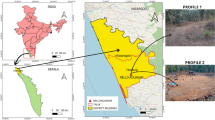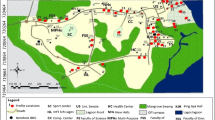Abstract
Understanding of subsurface anomalies has always been of interest to the geotechnical and geological engineers. Identification of dimensions and the location of these anomalies are still controversial at deeper depths due to a reduction in the resolution and the accuracy of recorded data. In this paper, the propagation mechanisms of the longitudinal (P), Rayleigh (R) and shear (S) waves are compared to investigate the ability of P waves in cavity detection in half-space and layered soil media. The results obtained from the analysis of the propagated P waves from the cavity show that the location of the cavity can be revealed in homogeneous half-space media. Hence, filtering methods and large amplitude clipping of the direct P and R waves are used to detect diffracted waves and provide a more precise illustration of propagated waves, especially in 3D view. The diffracted waves from the cavity appear as a symmetrical arc in the wave-field in which the peak point indicates the location of the cavity. However, the shape (slope) of the three curved paths corresponding to the diffracted waves from the boundary between two layers is not symmetric and gradually turns to a linear form as the distance increases. Furthermore, it is difficult to detect deep cavity using Rayleigh waves in layered soil media. For this purpose, seismic sources with low frequencies or passive methods should be used.














Similar content being viewed by others
References
Cardarelli, E., Cercato, M., Cerreto, A., & Di Filippo, G. (2010). Electrical resistivity and seismic refraction tomography to detect buried cavities. Geophysical Prospecting, 58(5), 685–695.
Chai, H. Y., Goh, S. H., Phoon, K. K., Wei, C. F., & Zhang, D. J. (2014). Effects of source and cavity depths on wave fields in layered media. Journal of Applied Geophysics, 107, 163–170.
Chai, H. Y., Phoon, K. K., Goh, S. H., & Wei, C. F. (2012). Some theoretical and numerical observations on scattering of Rayleigh waves in media containing shallow rectangular cavities. Journal of Applied Geophysics, 83, 107–119.
Davoodi, M., Pourdeilami, A., Jahankhah, H, & Jafari, M.K. (2018). Application of perfectly matched layer to soil-foundation interaction analysis. Journal of Rock Mechanics and Geotechnical Engineering.
Grandjean, G., & Leparoux, D. (2004). The potential of seismic methods for detecting cavities and buried objects: experimentation at a test site. Journal of Applied Geophysics, 56(2), 93–106.
Karray, M., Lefebvre, G., & Vannobel, P. (2009). Modal analysis of surface wave in geotechnical investigation—case study. International Journal of Geotechnical Engineering, 3(2), 187–203.
Lin, S., & Ashlock, J. C. (2014). Multimode Rayleigh wave profiling by hybrid surface and borehole methods. Geophysical Journal International, 197(2), 1184–1195.
Lin, S., & Ashlock, J. C. (2016). Surface-wave testing of soil sites using multichannel simulation with onereceiver. Soil Dynamics and Earthquake Engineering, 87, 82–92.
Miller, R. D., Xia, J., Park, C. B., & Ivanov, J. (2000). Shear wave velocity field from surface waves to detect anomalies in the subsurface. Geophysics, 4, 8-1.
Mirassi, S., & Rahnema, H. (2019). Effect of frequency content of seismic source load on Rayleigh and P waves in soil media with cavity. Journal of Structural and Construction Engineering. https://doi.org/10.22065/jsce.2019.176403.1808. (accepted).
Mirassi, S., & Rahnema, H. (2020). Improving the performance of absorbing layers with increasing damping in the numerical modeling of surface waves propagation using finite element method. Scientific Quarterly Journal of Iranian Association of Engineering Geology (accepted).
Mirassi, S., & Rahnema, H. (2021). Effect of acquisition parameters on the resolution of dispersion image in multi-channel analysis of surface waves method. Sharif Journal of Civil Engineering. https://doi.org/10.24200/j30.2019.53491.2551.
Mirassi, S., Rahnema, H., & Dal Moro, G. (2019). Cavity effect on Rayleigh wave dispersion and P-wave refraction. Earthquake Engineering and Engineering Vibration (accepted).
Morikawa, H., Sawada, S., & Akamatsu, J. (2004). A method to estimate phase velocities of Rayleigh waves using microseisms simultaneously observed at two sites. Bulletin of the Seismological Society of America, 94(3), 961–976.
Nasseri-Moghaddam, A., Cascante, G., & Hutchinson, J. (2005). A new quantitative procedure to determine the location and embedment depth of a void using surface waves. Journal of Environmental & Engineering Geophysics, 10(1), 51–64.
Nasseri-Moghaddam, A., Cascante, G., Phillips, C., & Hutchinson, D. J. (2007). Effects of underground cavities on Rayleigh waves—Field and numerical experiments. Soil Dynamics and Earthquake Engineering, 27(4), 300–313.
Park, C. B., Miller, R. D., Rydén, N., Xia, J., & Ivanov, J. (2005). Combined use of active and passive surface waves. Journal of Environmental and Engineering Geophysics, 10(3), 323–334.
Park, C. B., Miller, R. D., & Xia, J. (1999). Multichannel analysis of surface waves. Geophysics, 64(3), 800–808.
Pettit, J. R., Walker, A., Cawley, P., & Lowe, M. J. S. (2014). A stiffness reduction method for efficient absorption of waves at boundaries for use in commercial finite element codes. Ultrasonics, 54(7), 1868–1879.
Rahnema, H., & Mirasi, S. (2012). Seismic and geotechnical study of land subsidence and vulnerability of rural buildings. International Journal of Geosciences, 3(04), 878.
Rahnema, H., & Mirassi, S. (2016). Study of land subsidence around the city of Shiraz. Scientia Iranica, Transaction A, Civil Engineering, 23(3), 882.
Rajagopal, P., Drozdz, M., Skelton, E. A., Lowe, M. J., & Craster, R. V. (2012). On the use of absorbing layers to simulate the propagation of elastic waves in unbounded isotropic media using commercially available finite element packages. NDT & E International, 51, 30–40.
Schwenk, J. T., Sloan, S. D., Ivanov, J., & Miller, R. D. (2016). Surface-wave methods for anomaly detection. Geophysics, 81(4), 29–42.
Shaaban, F., Ismail, A., Massoud, U., Mesbah, H., Lethy, A., & Abbas, A. M. (2013). Geotechnical assessment of ground conditions around a tilted building in Cairo-Egypt using geophysical approaches. Journal of the Association of Arab Universities for Basic and Applied Sciences, 13(1), 63–72.
Shao, G. Z., Tsoflias, G. P., & Li, C. J. (2016). Detection of near-surface cavities by generalized S-transform of Rayleigh waves. Journal of Applied Geophysics, 129, 53–65.
Shi, P. (2015). Surface wave propagation effects on buried segmented pipelines. Journal of Rock Mechanics and Geotechnical Engineering, 7(4), 440–451.
Sloan, S. D., Peterie, S. L., Miller, R. D., Ivanov, J., Schwenk, J. T., & McKenna, J. R. (2015). Detecting clandestine tunnels using near-surface seismic techniques. Geophysics, 80(5), 127–135.
Van Renterghem, C., Schmelzbach, C., Sollberger, D., & Robertsson, J. O. (2017). Spatial wavefield gradient-based seismic wavefield separation. Geophysical Journal International, 212(3), 1588–1599.
Xia, J., Miller, R. D., Xu, Y., Luo, Y., Chen, C., Liu, J., et al. (2009). High-frequency Rayleigh-wave method. Journal of Earth Science, 20(3), 563–579.
Xia, J., Nyquist, J. E., Xu, Y., Roth, M. J., & Miller, R. D. (2007). Feasibility of detecting near-surface feature with Rayleigh-wave diffraction. Journal of Applied Geophysics, 62(3), 244–253.
Yoon, S., & Rix, G. J. (2009). Near-field effects on array-based surface wave methods with active sources. Journal of Geotechnical and Geoenvironmental Engineering, 135(3), 399–406.
Author information
Authors and Affiliations
Corresponding author
Ethics declarations
Conflict of interest
On behalf of all authors, the corresponding author states that there is no conflict of interest.
Additional information
Publisher's Note
Springer Nature remains neutral with regard to jurisdictional claims in published maps and institutional affiliations.
Rights and permissions
About this article
Cite this article
Mirassi, S., Rahnema, H. Deep cavity detection using propagation of seismic waves in homogenous half-space and layered soil media. Asian J Civ Eng 21, 1431–1441 (2020). https://doi.org/10.1007/s42107-020-00288-2
Received:
Accepted:
Published:
Issue Date:
DOI: https://doi.org/10.1007/s42107-020-00288-2




